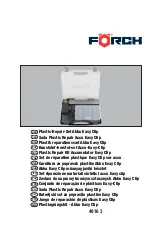
DEF TANK REPLENISHMENT SYSTEM • OPERATION MANUAL — REV. #0 (09/11/20) — PAGE 13
DEF TANK COMPONENTS
The definitions below describe the controls and functions
of the DEF tank (Figure 4).
1.
DEF Dispenser Kit Access Panel
— Remove this
panel to install the DEF Dispenser Kit. This kit allows for
the transfer (remote filling) of DEF to other equipment.
Refer to
on page 7 for more
information.
2.
Pump / 3-Way Valve Access Panel
— Remove this
panel to gain access to the pump, valve and other
associated components related to the DEF tank.
3.
DEF Fill Cap
— Remove this cap when filling of the
DEF tank is required.
DO NOT
overfill. For security
purposes, the cap is lockable.
4.
Documentation Box
— Storage for documentation
and other information regarding the DEF tank.
5.
Sight Glass
— Displays fault code information via
a series of LED flashes. Refer to
on page 18 of this manual for a list of error
codes/faults.
6.
Fill Hose Opening (Unit B)
— Run the DEF fill
hose through this hole opening to the fill port on the
generator.
7.
Lockable Storage Compartment (Unit B)
— Open
to gain access to the DEF fill hose. Can also be used
to store accessories.
8.
DEF Drain Port
— Place a drain pan underneath this
port when draining of the DEF is required. The drain
valve must be placed in the
open
position before
draining can start.
9.
Lockable Storage Compartment (Unit A)
— Open
to gain access to the DEF fill hose. Can also be used
to store accessories.
10.
Tie-Down Point
— Use these four tie-down points to
secure the unit during transport.
11.
Base
— Corrosion-resistant galvanized base.
12.
Forklift Pocket
— When lifting of the unit is required,
use these forklift pockets (8) to lift the unit. Remember
to insert the forks fully into the forklift pockets.
13.
Heating Pad Receptacle (Option)
— Apply 120 VAC
power via an extension cord to this receptacle. The
heating pad is placed between the skid base and the
DEF tank. The heating pad should be used in cold
weather conditions to prevent the freezing of DEF.
14.
Fill Hose Opening (Unit A)
— Run the DEF fill
hose through this hole opening to the fill port on the
generator.
15.
DEF Fill Hose Rack
— Wrap the hose around this
rack when not in use.
16.
Rubber Grommet
— Used for wiring connection
when the DEF Heated Hose is used. The DEF Heated
Hose heats fill lines in cold weather conditions. Refer
to
on page 7 for more
information.
17.
DEF Drain Access Cover
— Remove this cover to
gain access to the OPEN/CLOSE drain valve.
18.
DEF Level Gauge
— Displays the amount of DEF in
the internal tank.
19.
Level Check Switch
— Push this momentary switch
upwards and read the DEF level gauge to determine
the amount of DEF in the tank. Connection to an
application is required for powering of the gauge.
20.
System OK Status LED
— When lit (
GREEN
),
indicates that the system is operating correctly.
21.
Cycle Status LED (Unit A)
— When lit (
GREEN
),
indicates that pumping of DEF is in process.
22.
Fault Status LED (Unit A)
— When lit (
RED
), indicates
that a fault/error has occured. Refer to
on page 18 of this manual for a list of error
codes/faults.
23.
Cycle Status LED (Unit B)
— When lit (
GREEN
),
indicates that pumping of DEF is in process (
option
).
24.
Fault Status LED (Unit B)
— When lit (
RED
), indicates
that a fault/error has occured. Refer to
on page 18 of this manual for a list of error
codes/faults (
option
).
25.
Communication Port A
— Allows for CANBUS
communication between the DEF tank and the
generator. This port comes standard on the DEFTANK1
model.
26.
Communication Port B
— Allows for CANBUS
communication between the DEF tank and the
generator. This port can be added to the DEFTANK1
model as an option. Standard on the DEFTANK2 model.
27.
Controller
— The controller monitors DEF level,
purging of supply lines, and fault detection.








































